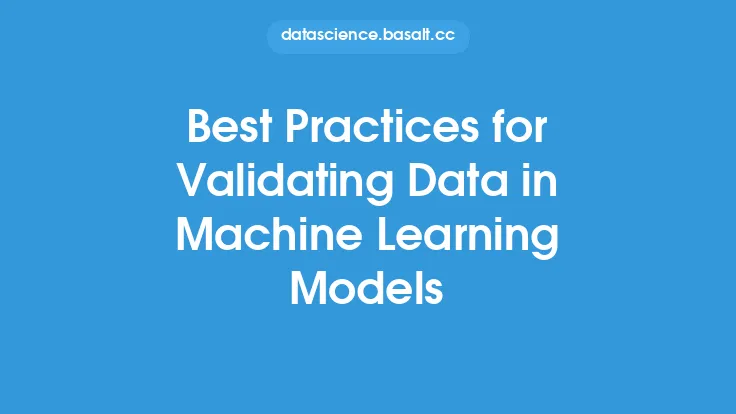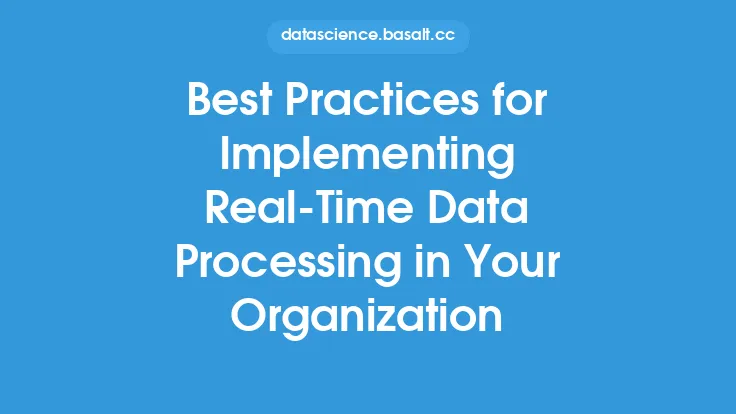Implementing data normalization in machine learning pipelines is a crucial step to ensure the quality and reliability of the data used for training models. Data normalization is the process of transforming numeric data into a common scale, usually between 0 and 1, to prevent features with large ranges from dominating the model. In this article, we will discuss the best practices for implementing data normalization in machine learning pipelines, including the different techniques, considerations, and tools used in the process.
Introduction to Data Normalization Techniques
There are several data normalization techniques used in machine learning, including min-max scaling, standardization, and logarithmic scaling. Min-max scaling, also known as normalization, is a technique that rescales the data to a common range, usually between 0 and 1, to prevent features with large ranges from dominating the model. Standardization, on the other hand, is a technique that subtracts the mean and divides by the standard deviation for each feature, resulting in a mean of 0 and a standard deviation of 1. Logarithmic scaling is a technique that transforms the data using the logarithmic function, which is useful for data with a large range of values.
Considerations for Implementing Data Normalization
When implementing data normalization in machine learning pipelines, there are several considerations to keep in mind. First, it is essential to understand the distribution of the data and the type of features being normalized. For example, if the data is skewed, it may be necessary to use a technique such as logarithmic scaling to transform the data. Second, it is crucial to consider the type of model being used, as some models are more sensitive to the scale of the data than others. For example, neural networks are more sensitive to the scale of the data than decision trees. Third, it is necessary to consider the computational resources available, as some normalization techniques can be computationally expensive.
Tools and Libraries for Data Normalization
There are several tools and libraries available for data normalization, including scikit-learn, TensorFlow, and PyTorch. Scikit-learn is a popular machine learning library for Python that provides a range of normalization techniques, including min-max scaling and standardization. TensorFlow and PyTorch are popular deep learning libraries that provide tools for data normalization, including batch normalization and layer normalization. Additionally, there are several other libraries available, such as pandas and NumPy, that provide tools for data manipulation and normalization.
Best Practices for Implementing Data Normalization
To implement data normalization effectively in machine learning pipelines, there are several best practices to follow. First, it is essential to normalize the data before splitting it into training and testing sets, to prevent data leakage. Second, it is crucial to use the same normalization technique for all features, to prevent inconsistent scaling. Third, it is necessary to save the normalization parameters, such as the mean and standard deviation, to use for normalization during testing and deployment. Fourth, it is essential to monitor the performance of the model on a validation set, to ensure that the normalization technique is not overfitting or underfitting the data.
Common Challenges and Solutions
There are several common challenges and solutions to consider when implementing data normalization in machine learning pipelines. One common challenge is dealing with missing values, which can be handled by imputing the missing values with the mean or median of the feature. Another common challenge is dealing with outliers, which can be handled by using techniques such as winsorization or trimming. Additionally, it is essential to consider the interpretability of the model, as some normalization techniques can make it difficult to interpret the results.
Conclusion and Future Directions
In conclusion, implementing data normalization in machine learning pipelines is a crucial step to ensure the quality and reliability of the data used for training models. By following the best practices outlined in this article, including using the right normalization technique, considering the type of model and data, and monitoring the performance of the model, it is possible to implement data normalization effectively. Future directions for research and development in data normalization include the development of new normalization techniques, such as those that can handle high-dimensional data, and the integration of data normalization with other machine learning techniques, such as feature selection and engineering.





